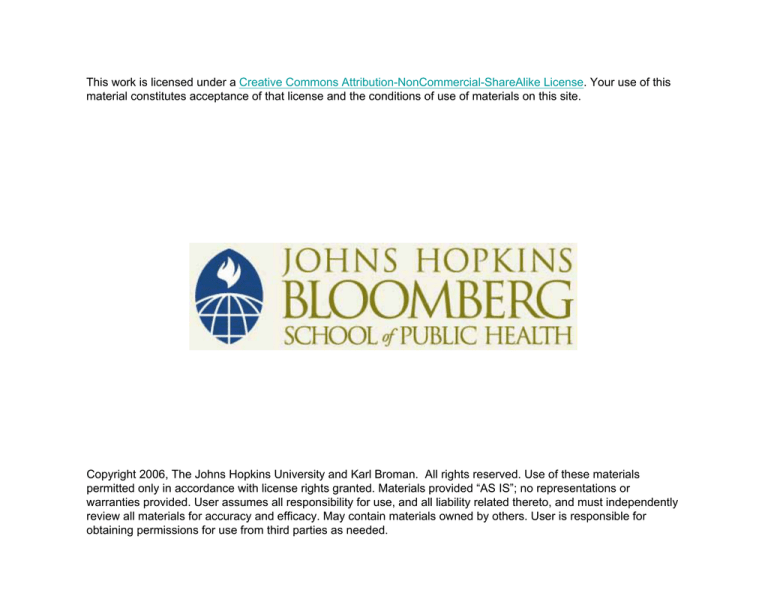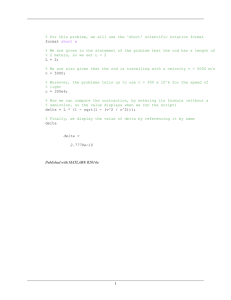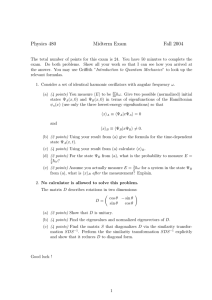
This work is licensed under a Creative Commons Attribution-NonCommercial-ShareAlike License. Your use of this
material constitutes acceptance of that license and the conditions of use of materials on this site.
Copyright 2006, The Johns Hopkins University and Karl Broman. All rights reserved. Use of these materials
permitted only in accordance with license rights granted. Materials provided “AS IS”; no representations or
warranties provided. User assumes all responsibility for use, and all liability related thereto, and must independently
review all materials for accuracy and efficacy. May contain materials owned by others. User is responsible for
obtaining permissions for use from third parties as needed.
Sample size calculations
n
=
$ available
$ per sample
Too few animals −→ A total waste
Too many animals −→ A partial waste
Power
X 1, . . . , X n iid normal(µA, σA)
Y 1, . . . , Y m iid normal(µB , σB )
Test H0 : µA = µB vs Ha : µA 6= µB at α = 0.05.
Test statistic: T =
X̄ − Ȳ
.
c
SD(X̄ − Ȳ )
Critical value: C such that Pr(|T| > C | µA = µB ) = α.
Power: Pr(|T| > C | µA 6= µB )
Power
−C
0
∆
C
Power depends on...
• The
design of your experiment
• What
test you’re doing
• Chosen
significance level, α
• Sample size
• True
difference, µA − µB
• Population SD’s, σA and σB .
The case of known population SDs
Suppose σA and σB are known.
Then X̄ − Ȳ ∼ normal( µA − µB ,
q
σA2
n
+
σB2
m
)
X̄ − Ȳ
Test statistic: Z = q 2
σA
σB2
+
n
m
If H0 is true (µA = µB ), Z ∼ normal(0,1)
=⇒ C = zα/2 so that Pr(|Z| > C | µA = µB ) = α
For example, for α = 0.05, C = qnorm(0.975) = 1.96.
Power when the population SDs are known
If µA − µB = ∆, then Z =
Pr
|X̄ −Ȳ |
q
σ2 σ2
A
B
n +m
= Pr
!
> 1.96
X̄
q−Ȳ −∆
σ2 σ2
A
B
n +m
(X̄ − Ȳ ) − ∆
q
∼ normal(0,1)
σA2
σB2
n + m
= Pr
qX̄ −Ȳ
σ2 σ2
A
B
n +m
> 1.96 − q σ2∆
σ2
A
B
n +m
= Pr Z > 1.96 − q σ2∆
σ2
A
B
n +m
!
> 1.96 +Pr
!
!
+Pr
X̄
q−Ȳ −∆
σ2 σ2
A
B
n +m
qX̄ −Ȳ
σ2 σ2
A
B
n +m
< –1.96
< –1.96 − q σ2∆
σ2
A
B
n +m
+ Pr Z < –1.96 − q σ2∆
σ2
A
B
n +m
!
Calculations in R
Power = Pr Z > 1.96 − q σ2∆
σ2
A+ B
n
m
!
+ Pr Z < –1.96 − q σ2∆
σ2
A+ B
n
m
C <- qnorm(0.975)
se <- sqrt( sigmaAˆ2/n + sigmaBˆ2/m )
power <- 1 - pnorm(C - delta/se) +
pnorm(-C - delta/se)
Power curves
100
Power
80
60
n=20
n=10
n=5
40
20
0
− 2σ
−σ
0
∆
σ
2σ
!
!
!
Power depends on . . .
Power = Pr Z > C − q σ2∆
σ2
A+ B
n
m
!
+ Pr Z < −C − q σ2∆
σ2
A+ B
n
m
!
• Choice of α (which affects C )
Larger α → less stringent → greater power.
• ∆ = µA − µB = the true “effect.”
Larger ∆ → greater power.
• Population SDs, σA and σB
Smaller σ ’s → greater power.
• Sample sizes, n and m
Larger n, m → greater power.
Choice of sample size
We mostly influence power via n and m.
Power is greatest when
σA2
n
2
+ σmB is as small as possible.
Suppose the total sample size N = n + m is fixed.
σA2
n
2
+ σmB is minimized when n =
σA
σA+σB N
and m =
σB
σA+σB N
For example:
If σA = σB , we should choose n = m.
If σA = 2 σB , we should choose n = 2 m.
(e.g., if σA = 4 and σB = 2, we might use n=20 and m=10)
Calculating the sample size
Suppose we seek 80% power to detect a particular value of µA −
µB = ∆, in the case that σA and σB are known.
(For convenience here, let’s pretend that σA = σB and that we plan
to have equal sample sizes for the two groups.)
!
√ ∆
∆
Power ≈ Pr Z > C − q σ2 σ2 = Pr Z > 1.96 − σ√2n
A
B
n +m
√ ∆√ n
−→ Find n such that Pr Z > 1.96 − σ 2 = 80%.
√
∆√ n
σ 2
Thus 1.96 −
√
=⇒ n =
σ
∆
= qnorm(0.2) = –0.842.
√
[1.96 − (−0.842)] 2
=⇒ n = 15.7 × ( ∆σ )2
Equal but unknown population SDs
X 1, . . . , X n iid normal(µA, σ )
Y 1, . . . , Y m iid normal(µB , σ )
Test H0 : µA = µB vs Ha : µA 6= µB at α = 0.05.
q2
q
sA (n−1)+s2B (m−1)
c (X̄ − Ȳ ) = σ̂p 1 + 1
SD
σ̂p =
n+m−2
n
m
Test statistic: T =
X̄ − Ȳ
.
c
SD(X̄ − Ȳ )
In the case µA = µB , T follows a t distribution with n + m – 2 d.f.
Critical value: C = qt(0.975, n+m-2)
Power: equal but unknown pop’n SDs
Power = Pr |X̄√−1Ȳ |1 > C
σ̂p
n+m
In the case µA − µB = ∆,
the statistic X̄√−1Ȳ 1 follows a non-central t distribution.
σ̂p
n+m
This distribution has two parameters:
degrees of freedom (as before)
the non-centrality parameter, √∆1
σ
1
n+m
C <- qt(0.975, n + m - 2)
se <- sigma * sqrt( 1/n + 1/m )
power <- 1 - pt(C, n+m-2, ncp=delta/se) +
pt(-C, n+m-2, ncp=delta/se)
Power curves
100
80
Power
60
40
n = 20
n = 10
n=5
known SDs
unknown SDs
20
0
− 2σ
−σ
0
∆
σ
2σ
A built-in function: power.t.test()
Calculate power (or determine the sample size) for the t-test when:
• Sample sizes equal
• Population SDs equal
Arguments:
• n = sample size
• delta = ∆ = µ2 − µ1
• sd = σ = population SD
• sig.level = α = significance level
• power = the power
• type = type of data (two-sample, one-sample, paired)
• alternative = two-sided or one-sided test
Examples
A. n = 10 for each group; effect = ∆ = 5; pop’n SD = σ = 10
power.t.test(n=10, delta=5, sd=10)
=⇒ 18%
B. power = 80%; effect = ∆ = 5; pop’n SD = σ = 10
power.t.test(delta=5, sd=10, power=0.8)
=⇒ n = 63.8 =⇒ 64 for each group
C. power = 80%; effect = ∆ = 5; pop’n SD = σ = 10; one-sided
power.t.test(delta=5, sd=10, power=0.8,
alternative="one.sided")
=⇒ n = 50.2 =⇒ 51 for each group
Unknown and different pop’n SDs
X 1, . . . , X n iid normal(µA, σA)
Y 1, . . . , Y m iid normal(µB , σB )
Test H0 : µA = µB vs Ha : µA 6= µB at α = 0.05.
Test statistic: T =
qX̄ −Ȳ
s2A s2B
n +m
To calculate the critical value for the test, we need the null distribution of T (that is, the distribution of T if µA = µB ).
To calculate the power, we need the distribution of T given the
value of ∆ = µA − µB .
We don’t really know either of these.
Power by computer simulation
• Specify n, m, σA, σB , and ∆ = µA −µB , and the significance
level, α.
• Simulate data under the model.
• Perform the proposed test and calculate the P-value.
• Repeat many times.
Example: n = 5, m = 10, σA = 1, σB = 2,
∆ = 0.0, 0.5, 1.0, 1.5, 2.0 or 2.5.
∆=0
0.0
0.0
0.2
0.4
0.2
0.6
1.0
0.0
0.2
0.4
0.6
P−value
∆ = 1.0
∆ = 1.5
0.4
0.2
0.8
P−value
0.6
0.8
1.0
0.0
0.2
0.4
0.6
P−value
P−value
∆ = 2.0
∆ = 2.5
0.4
0.6
0.8
1.0
0.0
0.2
0.4
P−value
0.6
P−value
100
80
60
Power
0.0
∆ = 0.5
40
20
0
0.0
0.5
1.0
∆
1.5
2.0
2.5
0.8
1.0
0.8
1.0
0.8
1.0
Determining sample size
The things you need to know:
• Structure of the experiment
• Method for analysis
• Chosen significance level, α (usually 5%)
• Desired power (usually 80%)
• Variability in the measurements
– If necessary, perform a pilot study, or use data from prior experiments or
publications
• The smallest meaningful effect
Reducing sample size
• Reduce the number of treatment groups being compared.
• Find a more precise measurement (e.g., average survival time
rather than proportion dead).
• Decrease the variability in the measurements.
– Make subjects more homogenous.
– Use stratification.
– Control for other variables (e.g., weight).
– Average multiple measurements on each subject.






